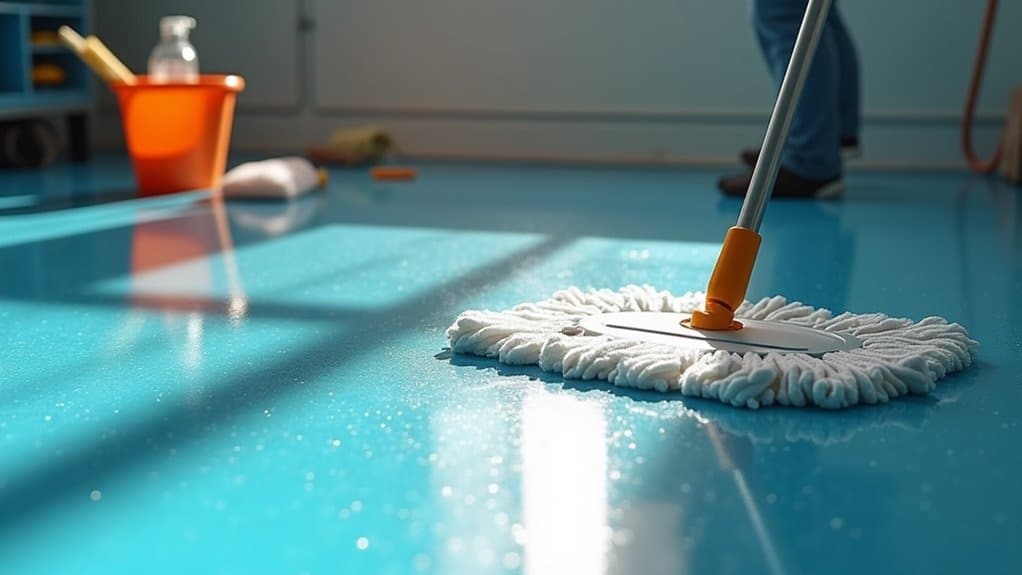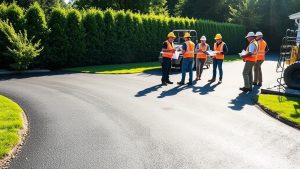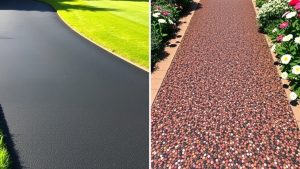To ensure your epoxy flooring lasts, begin with daily sweeping using a soft-bristled broom to clear away debris without scratching the surface. For a deeper clean, mop with a pH-neutral soap mixed with warm water, steering clear of harsh chemicals. Address spills promptly with a wet/dry vacuum or a soft cloth to prevent staining. Regularly check high-traffic areas for wear and consider applying UV-resistant sealants for added protection. If scratches appear, clean the area, fill it with epoxy filler, and sand it down for a smooth finish. By following these steps, you can maintain both the appearance and durability of your flooring.
Table of Contents
ToggleKey Takeaways
- Regularly sweep and mop with pH-neutral solutions to prevent dirt from building up and to keep the epoxy coating in good condition.
- Address spills immediately with a wet/dry vacuum or a soft cloth to avoid staining and damage from chemicals.
- Place protective mats at entryways to catch dirt and moisture, which will help reduce wear in busy areas.
- Plan for a monthly deep clean using low-pressure power washing to tackle stubborn stains without harming the surface.
- Perform regular inspections to spot any wear and carry out timely repairs to prolong the life of your epoxy flooring.
Importance of Regular Maintenance
Regular maintenance of epoxy flooring is crucial for its longevity and performance, significantly extending the life of your investment. Routine check-ups prevent dirt, debris, and stains from building up on the surface, which can damage the epoxy coating. Areas with heavy foot traffic require more frequent attention to minimise wear and tear.
Additionally, heavy equipment and sharp objects can scratch the surface, but regular cleaning helps keep it looking pristine. The durability of epoxy flooring ensures it withstands heavy foot traffic, making ongoing maintenance even more essential.
Using the right maintenance tools is essential. Choose a pH-neutral cleaner and a soft mop or cloth for cleaning, steering clear of harsh chemicals and abrasive tools that could harm the coating. A monthly steam clean can effectively tackle stubborn dirt and bacteria. For tougher stains, diluted ammonia solutions are effective and safe for epoxy.
Set up a maintenance schedule that includes weekly or biweekly sweeping and vacuuming, alongside deep cleaning every few months or as recommended by the manufacturer.
This proactive approach not only preserves the durability and appearance of your epoxy floors but also reduces the likelihood of costly repairs or replacements in the future.
Daily Sweeping Techniques

To keep your epoxy flooring in excellent condition, daily sweeping is key. A regular sweeping routine will help maintain both the appearance and longevity of your floor.
Here are four effective daily sweeping techniques:
- Choose the Right Tools: Use soft-bristled brooms or mechanised sweepers with soft bristles to avoid scratches. Dust mops are also great for quick debris removal.
- Sweep in One Direction: This technique prevents debris from scattering, ensuring every area is thoroughly cleaned.
- Pay Attention to High-Traffic Areas: Areas with heavy footfall, like garages or workshops, should be swept more often—ideally daily. Regular sweeping helps prevent dirt accumulation and potential scratches.
- Use Mats at Entryways: Placing mats can significantly reduce the dirt and moisture tracked in from outside, minimising the need for extensive cleaning.
Effective Debris Removal
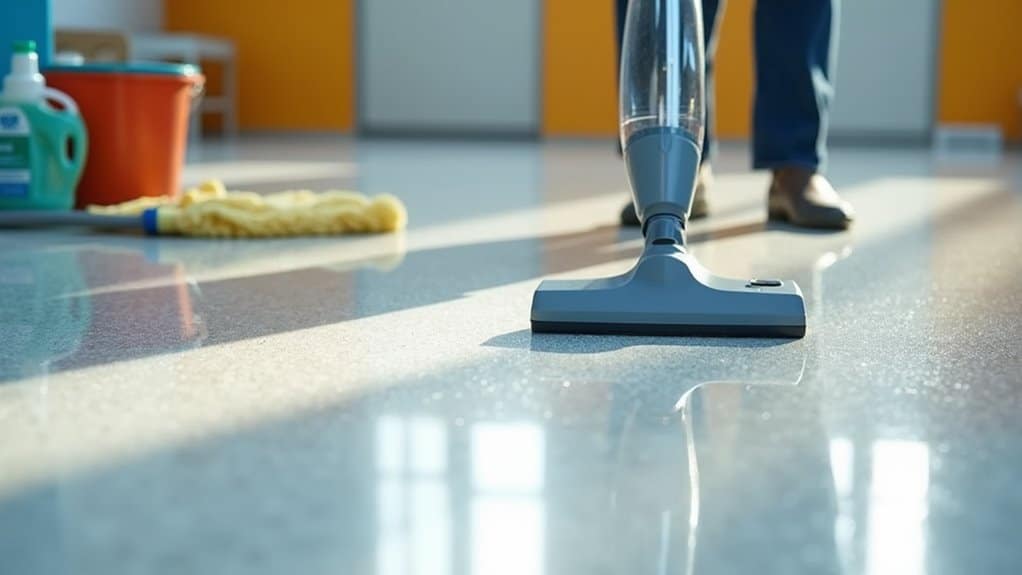
To keep your epoxy flooring in excellent condition, start with daily sweeping to remove loose debris and prevent scratches. Use floor mats at entry points to minimise dirt being brought inside, and conduct regular inspections to catch any buildup early. Additionally, ensure to check equipment regularly to maintain the effectiveness of your cleaning routine.
Daily Sweeping Techniques
Daily sweeping is crucial for maintaining epoxy flooring, helping to remove debris and prevent long-term damage. By using the right techniques and tools, you can keep your floors looking their best. Here are some essential tools to consider:
- Soft Bristle Brooms: These prevent scratches and are ideal for everyday use.
- Mechanised Sweepers: Great for larger areas, offering thorough cleaning.
- Dust Mops: Excellent for picking up fine dust and loose debris.
- Regular Frequency: Aim to sweep daily to minimise dirt and dust accumulation.
To keep your epoxy floor in top condition, establish a routine. Sweep high-traffic areas several times a day to ensure no debris is left behind. Regular cleaning prevents dirt and grit from dulling the epoxy surface, enhancing its longevity.
Use soft bristle brushes to avoid damaging the epoxy surface. For larger spaces, consider mechanised sweepers for efficiency. Dust mops are also handy for quick clean-ups.
Importance of Floor Mats
Maintaining a clean epoxy floor involves more than just regular sweeping; using floor mats can significantly enhance debris removal. The right mats play a crucial role in this process.
For example, sticky mats effectively capture dirt when people step on them, ensuring that contaminants stay off your epoxy surface. Rubber mats are perfect for high-traffic and wet areas, but they do require regular cleaning with specific products to remain effective. Additionally, regular sweeping is essential for maintaining epoxy flooring and preventing the accumulation of dirt and debris.
Welcome mats at entry points help trap dirt before it can reach your flooring, while anti-fatigue mats provide comfort and also reduce dirt build-up in work areas. Custom mats tailored to your specific needs can offer additional advantages for various environments.
To ensure maximum effectiveness, choose mats that are long enough for double-step use and consider layered options for better dirt capture. Regularly cleaning your mats will prolong their lifespan and improve their ability to trap debris.
Regular Debris Inspection
Regular debris inspection is essential for maintaining the integrity of your epoxy flooring. By routinely checking for different types of debris, you can prevent damage and keep the floor looking its best.
Here are four key steps for effective debris removal:
- Daily Sweeping: Use a soft-bristle broom or dust mop to remove loose debris. This helps prevent dirt and grit from scratching the surface.
- Vacuum Cleaning: Use a vacuum cleaner to get rid of finer dust particles. Regular vacuuming is particularly important in high-traffic areas to maintain the floor’s integrity.
- Spot Cleaning: For any stains, a mild soap solution with a microfiber mop works well. Clean spills promptly to stop stubborn stains from setting in.
- Deep Cleaning Techniques: Carry out steam cleaning once a month to tackle tougher dirt and bacteria. Avoid harsh chemicals, as these can damage the epoxy finish. Regular sweeping helps eliminate fine particles that can lead to surface scratches.
For the best results, aim for daily inspections.
Being diligent about checking for debris and using these effective removal methods can significantly prolong the life of your epoxy flooring while keeping it aesthetically pleasing.
Ideal Mopping Solutions

To keep your epoxy flooring spotless, use effective cleaning solutions specifically designed for this surface.
A simple mix of warm water and pH-neutral soap works well, while a microfiber mop ensures a thorough clean without leaving residue. Regular maintenance is crucial for enhancing the longevity of the floor and preventing any potential damage to the epoxy coating.
Knowing the correct mopping techniques and suitable cleaning products will help maintain your floor’s appearance and durability over time.
Effective Cleaning Mixtures
How can you ensure your epoxy flooring stays spotless with the right cleaning mixtures? The secret is in choosing effective, eco-friendly options.
Regular cleaning is vital for maintaining that clean appearance, and the right cleaning agents can make a big difference. Here are four recommended mixtures:
- Diluted Ammonia: Mix half a cup of ammonia with one gallon of hot water.
- Simple Green Epoxy Cleaner: Combine half a cup of Simple Green with one gallon of hot water.
- Windex Solution: Mix one part Windex with three parts water for removing residue.
- Non-Alkaline Soap: Add one-third of a cup of dishwashing soap to four or five litres of water.
Avoid harsh chemicals, enzymatic soaps, and citrus cleaners, as these can damage your epoxy surface.
Opt for pH-balanced cleaners to maintain the finish. For tough stains, use a stiff nylon brush with your cleaning solution, but limit scrubbing to two minutes.
Mopping Techniques to Use
Choosing the right cleaning solutions is just the first step in maintaining your epoxy flooring. Next, focus on effective mopping techniques. A microfiber mop is ideal as it’s gentle on the surface and efficiently picks up dirt. Foam or sponge mops made from synthetic materials like rayon are also suitable, but avoid those that shed lint or scratch the surface.
When mopping, work in systematic or overlapping sections to ensure even coverage. Dip your mop into the cleaning solution and wring out any excess water to prevent over-saturation. Use a light touch; pressing too hard can damage the epoxy coating. Remember to change your cleaning solution regularly to avoid spreading dirt.
After mopping, rinse the floor with clean water to remove any detergent residue. A garden hose or wet-dry vacuum can be effective for this. Finally, dry the floor thoroughly with paper towels or cloths to prevent slips and dust build-up.
Aim to mop regularly, ideally once a week, to maintain the shine and prevent scratches, thereby extending the life of your epoxy flooring.
Stain Identification Methods

Identifying stains on epoxy flooring is crucial for effective cleaning and maintenance. Here are four straightforward methods to help you identify them:
- Visual Inspection: Check for any colour changes, texture differences, and note the size and shape of the stain.
- Stain Classification: Determine the type of stain—whether it’s oil-based, water-based, chemical, organic, or inorganic—as each type requires a different removal approach.
- Stain Testing Techniques: Conduct physical and chemical tests to assess the stain’s reactivity. For instance, try using a pH-neutral cleaning solution or applying heat to see if there are any changes.
- Specialised Stain Identification: For more complex stains, consider using a chemical test kit or refer to manufacturer guidelines for a thorough analysis.
These methods will help ensure your epoxy flooring remains in top condition.
Immediate Spill Cleanup

When a spill happens on your epoxy floor, it’s crucial to act quickly to prevent staining and damage.
Use a wet/dry vacuum for liquid spills and a soft cloth to pick up solid debris.
Importance of Quick Response
Immediate response to spills on epoxy flooring is crucial for preserving its durability and appearance. Acting quickly can prevent damage, stains, and long-term issues that may compromise the floor’s integrity.
Here are four reasons why prompt spill response is important:
- Prevents Chemical Damage: Cleaning up immediately neutralises harmful substances, preventing etching or discolouration.
- Avoids Stubborn Stains: Addressing spills straight away decreases the chance of stains that are more difficult to remove later on.
- Maintains Safety: Quick action reduces slipping hazards from spills, ensuring adherence to safety protocols.
- Preserves Aesthetic Appeal: Timely cleaning keeps your epoxy flooring looking visually appealing and blemish-free.
When a spill occurs, follow safety protocols. Use soft cloths to blot spills and steer clear of abrasive tools that could damage the surface.
Deal with standing water immediately to avoid delamination. Remember, the longer you wait, the higher the risk of irreversible damage.
Effective Cleanup Techniques
To effectively manage spills on epoxy flooring, it’s essential to act quickly and use the right techniques to minimise damage. Immediate action is crucial for spill prevention and preserving the longevity of your floor. Here are some essential cleaning tools for tackling spills:
| Spill Type | Recommended Action |
|---|---|
| Liquid Spills | Use a soft cloth with a mild detergent. |
| Solid Spills | Gently scrape with a plastic scraper. |
| General Cleaning | Mop using pH-neutral cleaners or Simple Green. |
| Chemical Spills | Apply Windex to neutralise and clean. |
When cleaning, steer clear of acidic or abrasive products, as these can harm the epoxy surface. Always use non-abrasive tools to avoid scratching. After addressing spills, maintain your floor with daily sweeping and regular mopping using a mild cleaner. This proactive approach not only keeps your floors looking good but also enhances safety by reducing slippery conditions. Remember, prompt spill cleanup with the right tools is key to preserving your epoxy flooring.
Heavy Duty Cleaning Tips

For homeowners dealing with tough cleaning challenges on epoxy floors, a few heavy-duty cleaning tips can help maintain their appearance and longevity. Here are some key strategies:
- Use Stiff Nylon Brushes: For stubborn stains, a stiff nylon brush with a diluted ammonia or Simple Green solution can effectively lift grime without harming the surface.
- Opt for Lactic Acid-Based Cleaners: If you encounter rust stains, a lactic acid-based cleaner like CLR, mixed with equal parts water, can help remove them effectively.
- Steam Clean Monthly: A steam cleaner can thoroughly sanitise your floors, removing built-up dirt and bacteria while preserving the integrity of the epoxy.
- Avoid Abrasive Tools: Always opt for non-abrasive cleaning supplies to protect the epoxy finish from scratches and damage.
Power Washing Guidelines

Before you begin power washing your epoxy floor, ensure you have the right equipment, including a rotary scrubber and surface cleaner.
Use approved cleaning solutions that are gentle on epoxy, such as neutral pH cleaners, to effectively lift dirt without causing damage.
Start with low pressure to avoid harming the surface while effectively removing grime and stains.
Equipment Preparation Essentials
Preparing your equipment for power washing epoxy flooring is essential for effective cleaning without damaging the surface. Here are four key points to consider:
- Water Pressure Settings: Use moderate to low pressure to safeguard the epoxy coating.
- Nozzle Types: Choose wide-angle or fan spray nozzles for even water distribution, reducing concentrated pressure on the surface.
- Distance: Keep the nozzle at least 18 inches away from the floor to lessen impact pressure.
- Test Area: Always test the power washer on a small, hidden area first to see how it affects the epoxy.
By following these guidelines, you can achieve a successful cleaning process.
Using a 45-degree angle tip can further help to reduce impact pressure.
Always check the manufacturer’s recommendations, as each epoxy floor may have specific needs.
Taking these precautions will help you clean your epoxy flooring effectively while maintaining its integrity and appearance for years to come.
Approved Cleaning Solutions
Choosing the right cleaning solutions is crucial for preserving your epoxy flooring while ensuring it stays clean. For regular maintenance, use diluted ammonia by mixing 2-3 ounces with a gallon of hot water. This solution is great for spot cleaning without harming the epoxy.
Alternatively, diluted Simple Green, mixed at a ratio of 1 part to 8 parts hot water, works well too. Windex, when diluted with water at a 1:3 ratio, effectively removes residue and leaves a streak-free finish.
For regular cleaning, opt for mild, pH-neutral detergents or specialised epoxy cleaners like Epoxy Floor Cleaner to keep the glossy finish intact. These products effectively clean without damaging the surface.
When power washing, use low to moderate pressure settings and a wide-angle nozzle to avoid causing damage. Keep a safe distance from the floor and always test on a small area first.
Avoid harsh chemicals, as they can deteriorate your epoxy over time. By following these guidelines, you’ll ensure your flooring remains in excellent condition for years to come.
Proper Technique Practices
When maintaining your epoxy flooring, using the right technique during power washing is crucial for its durability and appearance. Here are some straightforward guidelines to follow:
- Choose the Right Equipment: Opt for a power washer with adjustable settings and a wide-angle nozzle for even water distribution.
- Keep Your Distance: Maintain a distance of about one foot from the floor to prevent excessive pressure.
- Angle the Nozzle: Position the nozzle at an angle rather than directly down to avoid concentrating pressure on one area.
- Conduct a Test: Always test the power washer on a small, hidden section before cleaning the entire floor.
Incorporating power washing into your maintenance routine is important, but do it wisely. Aim for a deep clean no more than once a month, as frequent washing can wear down the epoxy surface.
Always use a gentle detergent and wear protective gear. Consistent cleaning, combined with these techniques, will help keep your epoxy flooring looking great for years.
Understanding Epoxy Longevity Factors

Understanding the factors that affect the longevity of epoxy flooring is essential for ensuring optimal performance and durability. One major factor is the thickness and quality of the epoxy coating. Typically, coatings range from 400 to 1,000 microns, with thicker applications providing better durability. In industrial settings, coatings may exceed 1,000 microns to further enhance longevity.
Surface preparation is another critical aspect. Proper preparation creates a strong bond between the epoxy and concrete, significantly influencing its lifespan. The concrete should have a minimum strength of 3,000 PSI and must be clean, free from dust and moisture before application. Essential steps include cleaning, filling cracks, and sanding uneven areas; neglecting these can lead to premature chipping and peeling.
Environmental conditions also significantly impact epoxy performance. Epoxy has limited resistance to UV light, which can cause fading and damage when exposed to sunlight. For this reason, epoxy is best suited for stable, indoor environments.
If you need to use it outdoors, consider applying a urethane topcoat for added protection against UV damage and wear. By understanding these factors, you can make informed decisions to enhance the lifespan of your flooring.
Impact of Traffic on Epoxy

The impact of traffic on epoxy flooring is notable, as these surfaces are engineered to endure various levels of wear. Recognising how traffic patterns influence your epoxy can significantly extend its lifespan. Here are some key considerations:
- Foot Traffic: Areas with heavy foot traffic, such as shops or offices, may experience surface wear over time.
- Heavy Machinery: In industrial environments, heavy machinery can put stress on epoxy. While it’s built to withstand this, regular monitoring is essential.
- Frequent Spills: High-traffic spaces like schools and canteens often face spills that need swift cleaning to avoid damage.
- Regular Maintenance: Increased activity heightens the necessity for routine cleaning to keep the epoxy in good condition.
Epoxy flooring is extremely resistant to wear and tear, making it suitable for busy areas. It can handle impacts and substantial weights, but neglecting upkeep may lead to premature deterioration.
Regular cleaning is crucial to prevent dirt build-up and maintain its structural integrity. Keep an eye on evolving traffic patterns in your space; this awareness will help you adjust your maintenance routine, ensuring your epoxy flooring remains durable and visually appealing for years.
Proper Surface Preparation

Proper surface preparation is crucial for a durable and long-lasting epoxy flooring installation. Selecting the right method ensures ideal adhesion and longevity of your epoxy. Some common techniques include sanding, diamond grinding, and shot-blasting, each suited to specific situations.
Here’s a brief overview of surface preparation methods:
| Method | Best For | Key Feature |
|---|---|---|
| Sanding | Light surface prep | Quick and easy |
| Diamond Grinding | Various floor types | Effective and adaptable |
| Shot-Blasting | High-build flooring systems | High-velocity cleaning |
| Scarifying | Heavily contaminated floors | Aggressive removal |
| Acid Etching | Preparing new surfaces for epoxy | Chemical treatment |
When preparing the surface, consider the thickness of your coating and the quality of the concrete. Ensure the surface is clean and free from contaminants like grease or oil, as these can prevent proper adhesion. Using proper sanding techniques and diamond grinding is essential for maximising the epoxy’s lifespan. Following these guidelines will pave the way for a successful epoxy flooring installation.
Sunlight Exposure Effects
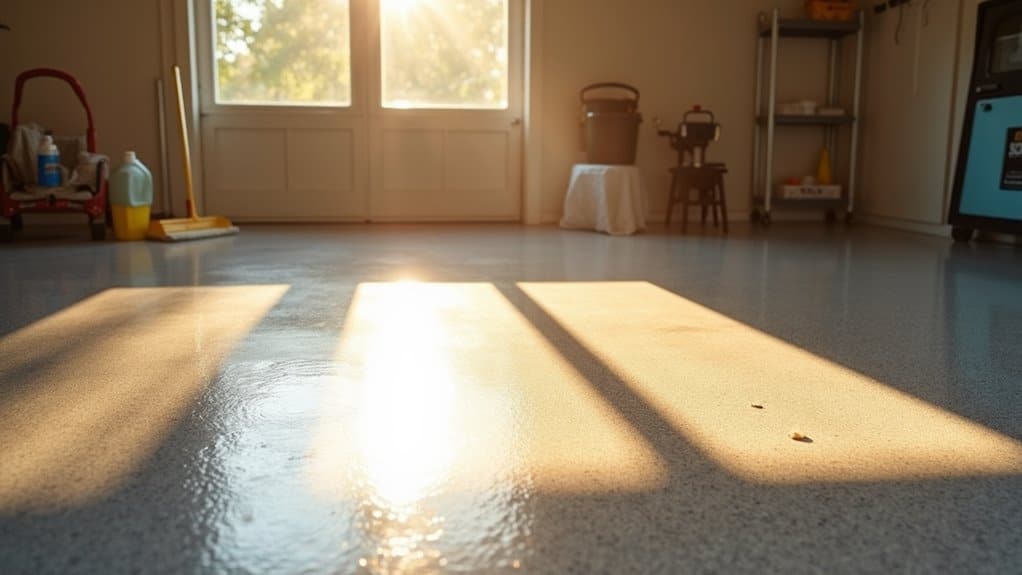
After ensuring a well-prepared surface for your epoxy flooring, it’s crucial to consider how sunlight exposure can affect its performance and appearance. Here are some key points to keep in mind:
- Discolouration: UV light can cause epoxy resin to darken or yellow over time, leading to an amber hue.
- Durability Concerns: Extended exposure to sunlight can weaken the epoxy, reducing its hardness and overall lifespan.
- Preventive Steps: Using UV-resistant top coats can help slow down discolouration and maintain the original colour.
- Material Choices: High-performance, UV-resistant epoxy formulations can enhance longevity and reduce degradation.
To address these issues, prioritise UV resistance during installation. Products like E2U Epoxy 4500 provide excellent UV protection, making them ideal for sunlit areas.
Additionally, using window treatments or UV-filtering films can significantly improve the durability and appearance of your epoxy flooring.
Inspecting for Damage

Inspecting your epoxy flooring regularly—ideally every 3 to 6 months—helps you identify potential issues before they worsen. Begin by checking for cracks, peeling, or bubbling. Pay particular attention to the edges where the epoxy meets the walls, as this area is prone to separation.
| Inspection Area | Signs to Look For | Action Required |
|---|---|---|
| Surface Uniformity | Divots, chips, or uneven spots | Schedule repairs promptly |
| Moisture Intrusion | Damp areas or loss of bond | Conduct moisture tests |
| Colour Consistency | Fading or discolouration | Consider reapplying the coating |
During your inspection, keep an eye out for moisture issues and stubborn stains. Check high-traffic areas more frequently, as they are more likely to wear down. If you spot any damage, address it quickly to prevent further deterioration. For significant or age-related problems, seek professional advice. Regular maintenance, including inspections, is crucial for the longevity of your epoxy floor, ensuring it stays in good condition and retains its visual appeal.
Repairing Scratches and Cracks

Repairing scratches and cracks in your epoxy flooring is crucial for preserving its appearance and structural strength. Neglecting these flaws can lead to more significant damage. Here are four effective repair techniques:
- Clean the area: Use a solvent cleaner to eliminate any dust or debris around the scratch.
- Apply epoxy filler: For deeper scratches, fill them with a specially formulated epoxy filler for a smooth finish.
- Sand and polish: Once the filler has cured, sand the area until smooth and apply a matching polish to blend the repair.
- Recoat the surface: Finally, apply a fresh layer of epoxy to restore a uniform look to the floor.
To prevent scratches, adopt regular maintenance practices such as sweeping and using non-abrasive cleaning tools.
By following these repair techniques and maintaining your floor, you can ensure its longevity and visual appeal.
Additional Protection Strategies

Implementing effective protection strategies is crucial for maintaining the integrity and appearance of your epoxy flooring. Start by placing floor mats at entryways to reduce dirt and moisture. This simple measure helps prevent water from seeping into the surface.
Avoid dragging sharp or heavy objects across the floor, as this can lead to scratches and dents. Consider applying a UV-resistant topcoat to protect your floor from sun damage and keep its colour vibrant.
Installing strong moisture barriers is also important, especially in areas susceptible to groundwater issues, ensuring your flooring remains intact. Temperature tolerance is key to the longevity of your epoxy.
Opt for a flexible topcoat that can adjust to temperature changes, reducing the risk of cracking. Additionally, scheduling your installation or repairs during drier seasons will improve curing conditions and durability.
Finally, applying a protective sealant adds an extra layer of defence against environmental factors. By following these strategies, you’ll not only safeguard your epoxy flooring but also prolong its life and maintain its appealing look.
Frequently Asked Questions
Can I Use a Steam Cleaner on Epoxy Floors?
You can use a steam cleaner on epoxy floors, as it effectively removes stains and sanitises the surface. However, be careful of potential downsides, such as damage from high pressure or harsh chemicals that may affect the finish.
How Often Should I Reapply Protective Coatings?
In commercial settings, it’s advisable to reapply protective sealants every 5 to 10 years. For residential properties, aim for every 15 to 20 years. However, adjust these timings based on foot traffic and the condition of the surface to ensure optimal protection.
What Are the Best Mats for Preventing Dirt?
To prevent dirt, opt for sturdy entry mats and outdoor mats with textured surfaces. Ensure they are sufficiently large for busy areas, and choose non-porous materials to prevent any chemical reactions that could harm your flooring.
Can I Use Bleach for Cleaning Epoxy Floors?
You might assume that bleach is effective for cleaning epoxy floors, but it can actually cause damage. Instead, opt for alternatives like mild soap. Regular cleaning with gentle methods will help maintain your flooring’s shine and durability.
How Do I Prevent Fading From Sunlight Exposure?
To prevent fading from sunlight exposure, apply UV protection coatings and opt for high-quality, UV-resistant epoxy. This helps maintain colour and protects your surfaces from harmful UV rays, ensuring they stay vibrant and durable for longer. For instance, consider using UV-resistant paint for outdoor furniture to keep it looking fresh through the seasons.
Conclusion
To keep your epoxy flooring in top condition, regular maintenance is essential. Think of it as giving your floor the care it needs to shine and withstand wear. Simple tasks like sweeping, mopping, and checking for damage help protect your floor and extend its lifespan. By following these straightforward strategies, you can ensure your epoxy flooring remains attractive and durable for many years to come. Just like a well-cared-for garden, your floor will reflect its upkeep through its beauty and resilience.
Prepare the perfect base for your resin bound stone installation and discover the crucial factors that ensure lasting durability.
Know where resin bound surfacing can transform spaces for both residential and commercial use, and discover the countless benefits that Read more
A stone carpet combines beauty and resilience in flooring, but what makes quartz floors uniquely beneficial? Discover the secrets behind Read more

